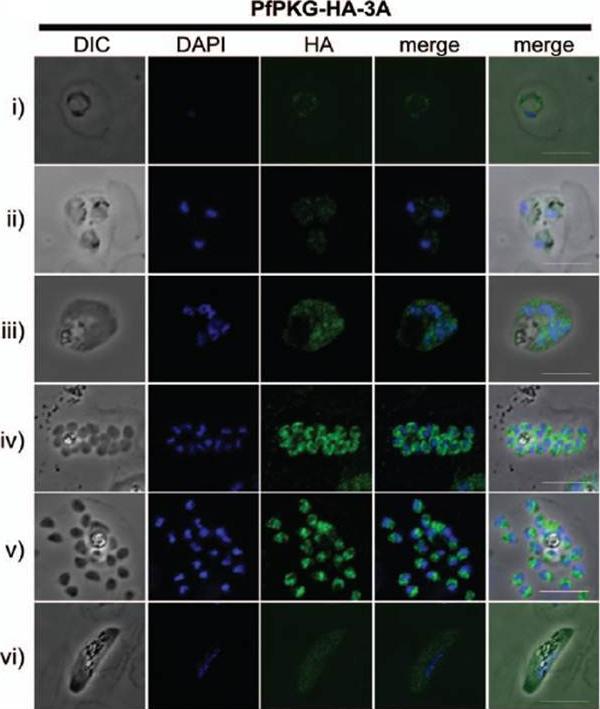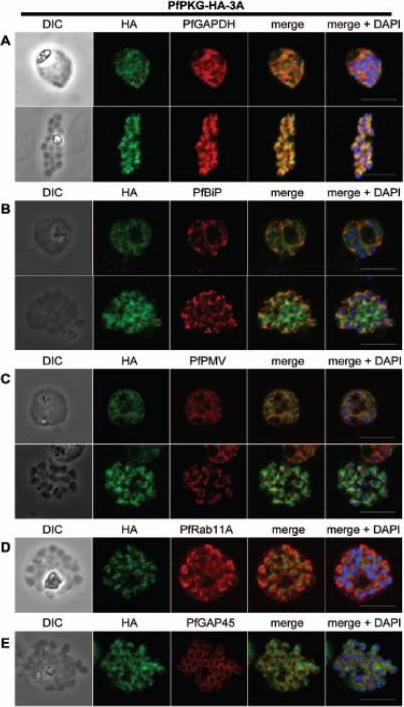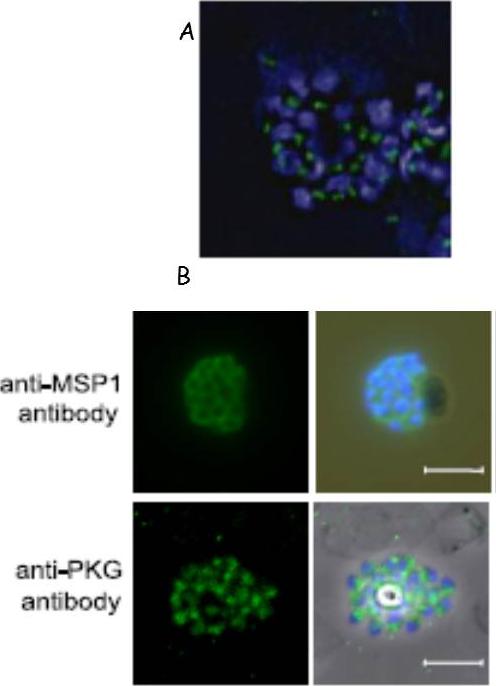PF3D7_1436600 cGMP-dependent protein kinase (PKG)
Disruptability [+]
| Species | Disruptability | Reference | Submitter | |
|---|---|---|---|---|
| P. falciparum 3D7 |
Refractory |
18532880 | Theo Sanderson, Wellcome Trust Sanger Institute | |
| P. falciparum 3D7 |
Refractory |
USF piggyBac screen (Insert. mut.) | USF PiggyBac Screen | |
| P. berghei ANKA |
Refractory |
RMgm-544 | Imported from RMgmDB | |
| P. berghei ANKA |
Refractory |
RMgm-325 | Imported from RMgmDB | |
Mutant phenotypes [+]
None reported yet. Please press the '+' button above to add one.Imaging data (from Malaria Metabolic Pathways)

Immunofluorescent anti-HA detection in fixed smears of erythrocytic stages of the PfPKG-HA-3A clone. Representative images of (i) a ring stage parasite, (ii) three early trophozoites, (iii) an early schizont, (iv, v) late schizonts (approximate hours post invasion: (i) 4–10, (ii) 20–26, (iii) 33–39, (iv, v) 45–48) and (vi) a stage III gametocyte are shown together with bright field images (first column) and parasite nuclei stained with DAPI (second column). Bars ,5 mm. epitope-tagged PfPKG was detected most strongly in late blood stage parasites. A diffuse pattern of relatively low level PfPKG expression was detected in ring and early trophozoite stages and gametocytes. Very similar results were obtained using PfPKG-PTP-1A clones, as well as the parental 3D7 parasites in conjunction with the commercial human PKG-I antibody. PfPKG is primarily found in the cytosol.Hopp CS, Flueck C, Solyakov L, Tobin A, Baker DA. Spatiotemporal and Functional Characterisation of the Plasmodium falciparum cGMP-Dependent Protein Kinase. PLoS One. 2012;7(11):e48206.
See original on MMP
Subcellular location of PfPKG in mature schizonts. Dual immunofluorescent detection of PfPKG-HA in fixed smears of early and late schizonts of the PfPKG-HA-3A clone together with (A) GAPDH; (B) BiP; (C) PMV; (D) Rab11A and (E) GAP45. Representative images are shown for each antibody, together with bright field images (first column) and parasite nuclei stained with DAPI (in the merged image). Bars ,5 mm. Significant overlap between the PKG-HA and GAPDH in early and late blood stage schizonts (A), both are in the cytosol. PfPKG-HA also partially overlapped with that of the ER membrane protein PMV and that of the ER lumen marker PfBiP (B and C) in both early and late schizonts. Rab11A is thought to be involved in vesicle trafficking and localises to the rhoptries and the inner membrane complex (IMC) at the apical end of the merozoite. In mature schizonts, the location of PKG-HA appeared to be largely distinct from that of Rab11A (D). PKG-HA appeared to be absent from the IMC in segmented schizonts, since it did not colocalise with the IMC marker, the glideosome associated protein 45. Hopp CS, Flueck C, Solyakov L, Tobin A, Baker DA. Spatiotemporal and Functional Characterisation of the Plasmodium falciparum cGMP-Dependent Protein Kinase. PLoS One. 2012;7(11):e48206.
See original on MMP
Fluorescence micrographs of schizonts. The primary antibody was a monoclonal antibody that reacts with the P. falciparum rhoptry neck protein PfRON4 (green). Nuclei were counterstained with 0.5 g/ml DAPI (blue). Scale bar, 5 mm. (B) Fluorescence micrographs of schizonts. The primary antibodies were a monoclonal antibody that reacts with P. falciparum MSP1 (top row) and a polyclonal antibody that reacts with PfPKG (bottom row) (both green). Nuclei were counterstained with 0.5 g/ml DAPI (blue). The staining pattern observed throughout the merozoites suggests a predominantly cytosolic localization.Taylor HM, McRobert L, Grainger M, Sicard A, Dluzewski AR, Hopp CS, Holder AA, Baker DA. The malaria parasite cyclic GMP-dependent protein kinase plays a central role in blood-stage schizogony. Eukaryot Cell. 2010 9:37-45.
See original on MMPMore information
| PlasmoDB | PF3D7_1436600 |
| GeneDB | PF3D7_1436600 |
| Malaria Metabolic Pathways | Localisation images Pathways mapped to |
| Previous ID(s) | PF14_0346 |
| Orthologs | PBANKA_1008200 , PCHAS_1009100 , PKNH_0423200 , PVP01_1312900 , PVX_084705 , PY17X_1009800 |
| Google Scholar | Search for all mentions of this gene |